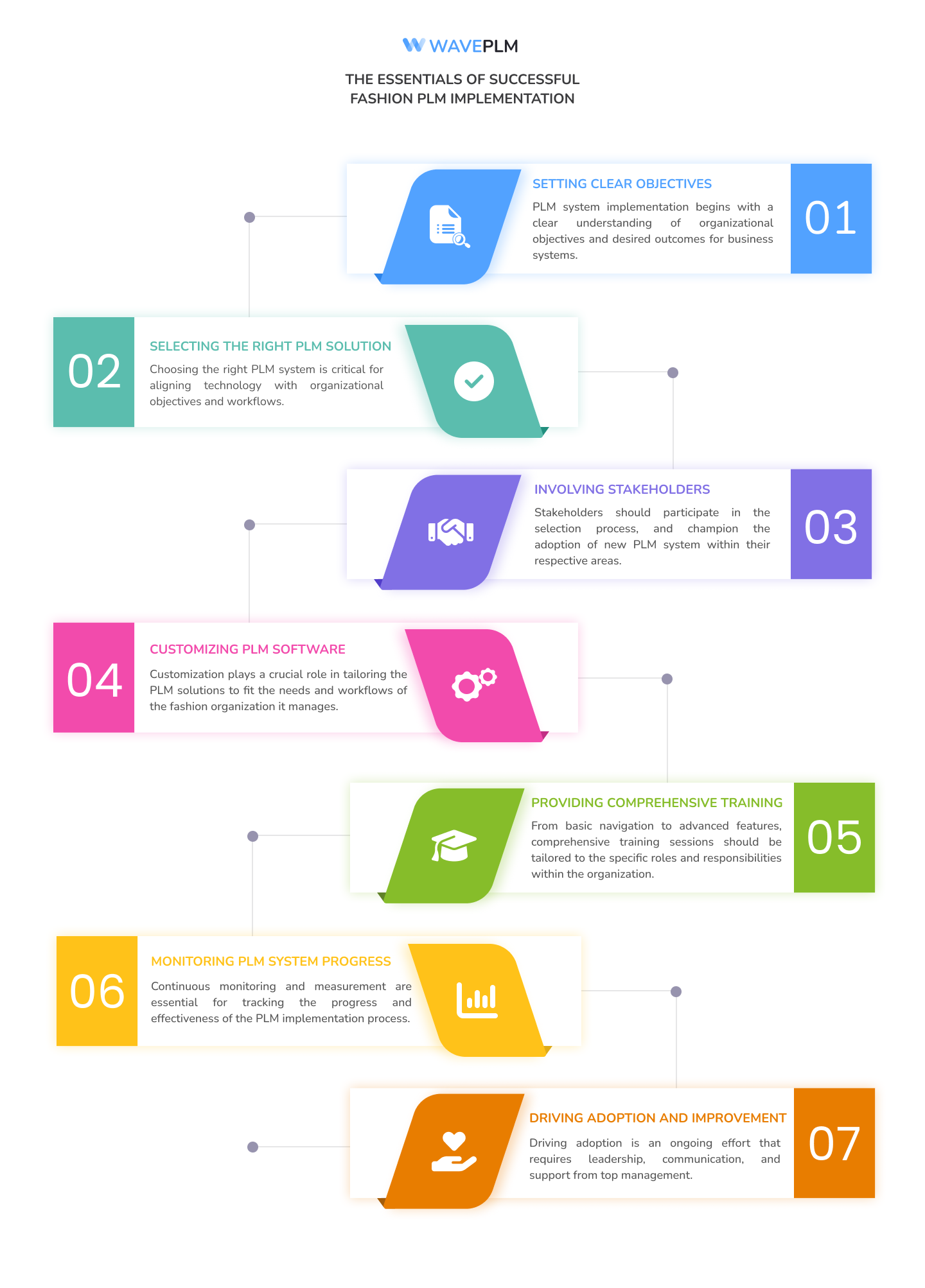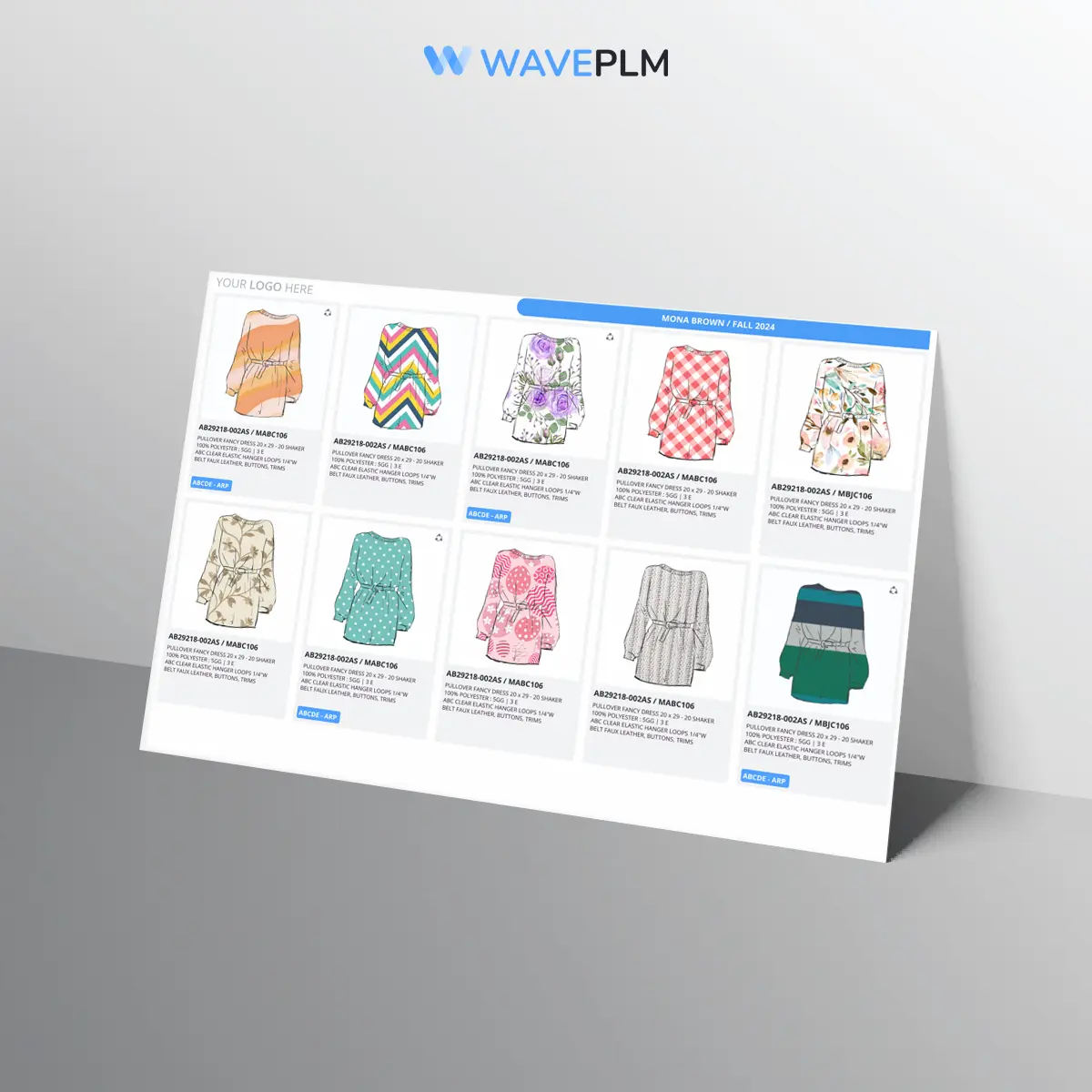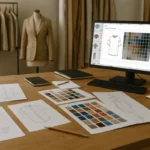
Product Lifecycle Management (PLM) has become an indispensable tool for businesses in the fashion industry aiming to streamline processes, enhance collaboration, and improve efficiency. However, PLM implementation requires meticulous planning, stakeholder engagement, and strategic execution.
This paper explores the essential steps for implementing a PLM strategy effectively in the fashion industry, drawing on real-world examples and best practices. From defining clear objectives to driving continuous improvement, each step is crucial for ensuring smooth sailing throughout the PLM and product development lifecycle and journey.
Introduction
The fashion industry is renowned for its dynamic nature, characterized by rapid changes in trends, consumer preferences, and supply chain complexities. In such a competitive landscape, efficiency data quality, and agility are paramount for fashion brands to stay ahead. This is where Product Lifecycle Management (PLM) systems play a pivotal role in digital transformation. PLM facilitates seamless collaboration, accelerates time-to-market, and enhances product quality by integrating various stages of the product lifecycle, from design to production and beyond.
However, implementing a PLM process successfully is no small feat. It requires a comprehensive understanding of organizational needs, meticulous planning, and effective execution. In this paper, we delve into the essentials of successful PLM implementation in the fashion industry, accompanied by real-world examples and best practices. From setting clear objectives to driving adoption and continuous improvement, each step is crucial for navigating the complexities of PLM, successful implementation, and achieving smooth sailing in the fashion product lifecycle.

1. Setting Clear Objectives
PLM system implementation begins with a clear understanding of organizational objectives and desired outcomes for business systems. Whether the goal is to streamline design processes, reduce time-to-market, or improve supply chain efficiency, articulating these objectives is essential. For example, a fashion brand might aim to enhance collaboration between design and production teams to expedite the design and development phase and launch of new collections. By setting clear objectives, stakeholders have a unified vision and roadmap for PLM implementation.
Real-world Example
Wave PLM identified a need to implement PLM to improve collaboration between its design and production teams to address delays in new product launches. By setting a clear objective of reducing time-to-market by 25%, they established a roadmap for PLM implementation focused on streamlining communication, automating workflows, and optimizing sample approvals system testing.
2. Selecting the Right PLM Solution
Choosing the right PLM system is critical for aligning technology with organizational objectives and workflows. Fashion brands should evaluate their PLM solutions and vendors based on factors such as industry expertise, scalability, ease of integration, and customization capabilities. Additionally, considering features tailored to the fashion industry, such as trend forecasting, material management, and supplier collaboration tools, is crucial. The selected PLM vendor and solution should not only address current needs but also accommodate future growth and innovation.
Real-world Example
ABC Fashion, a global brand, conducted a thorough evaluation of various PLM vendors before selecting a solution tailored to the fashion industry. With features such as digital sample and document management, product data management, 3D design integration, and mobile accessibility, the chosen PLM solution seamlessly integrated with ABC Fashion’s existing workflows and empowered teams to collaborate more effectively.
3. Involving Stakeholders from the Start
Stakeholder engagement is key to successful PLM system implementation. Involving cross-functional teams from different departments, including design, product development, sourcing, and IT, ensures that diverse perspectives are considered and requirements are addressed. Stakeholders should also participate in the selection process, provide input on customization needs, and champion the adoption of new PLM system within their respective areas. This collaborative approach fosters buy-in and ownership throughout the entire product lifecycle implementation journey.
Real-world Example
DEF Couture engaged stakeholders from the design, merchandising, and supply chain departments early in the full PLM project implementation change management process. By soliciting feedback on pain points and desired features, DEF Couture customized the PLM solution to align with the unique workflows and preferences of each team. This inclusive approach resulted in higher user adoption and smoother integration across departments.
4. Customizing and Configuring the PLM Software
Customization plays a crucial role in tailoring the PLM solutions to fit the specific needs and workflows of the fashion organization it manages. Working closely with the PLM software vendor, teams should customize features, configure user interfaces, and integrate with existing systems such as ERP and CAD software. Customization efforts should focus on optimizing efficiency, reducing manual tasks, and improving collaboration across teams and external partners.
Real-world Example
GHI Fashion implemented a PLM solution customized to support its seasonal collections and global supply chain. By integrating digital asset libraries, color management, production data and tools, and calendar-based workflows, GHI Fashion streamlined design approvals, product data management and production scheduling. Overall, the PLM solution was configured to accommodate multiple languages and currencies, facilitating seamless collaboration with overseas suppliers and vendors.
Some PLM solutions like Wave PLM offer customizable reports, like Line Sheets, Tech packs and others. Figure out what your team need before implementation.

5. Providing Comprehensive Training
Training is essential to ensure that users are proficient in utilizing the PLM system effectively. From basic navigation to advanced features, comprehensive training sessions should be tailored to the specific roles and responsibilities within the organization. Moreover, training can take various forms, including instructor-led workshops, online tutorials, and user manuals. Investing in training upfront pays dividends in terms of user adoption, productivity, and overall success of the PLM software implementation and the implementation process.
Real-world Example
Wave PLM system consistently provides unlimited training sessions during onboarding and at any other necessary times, ensuring smooth integration for its teams. This commitment to comprehensive training was evident as Wave PLM conducted extensive sessions for its design, product development, and sourcing teams following the implementation of a new PLM solution. As a result, employees were empowered to leverage the full capabilities and key benefits of the new product lifecycle management system, leading to improved collaboration and efficiency.
6. Monitoring and Measuring Progress of PLM system
Continuous monitoring and measurement are essential for tracking the progress and effectiveness of the PLM implementation process. Key Performance Indicators (KPIs) should be established to evaluate various aspects of PLM implementation team adoption, such as time-to-market, design iteration cycles, error rates, and user satisfaction. Regular assessments help identify areas for improvement, address challenges proactively, and make data-driven decisions to optimize the PLM system continuously.
Real-world Example
MNO Denim implemented a robust KPI framework to monitor the impact of PLM on its design product development processes and production processes. By tracking metrics such as sample turnaround time, revision cycles, and supplier responsiveness, MNO Denim gained insights into areas of inefficiency and opportunities for optimization. Overall, continuous monitoring allowed MNO Denim to refine workflows, automate repetitive tasks, and drive continuous improvement in PLM adoption and production process.
7. Driving Adoption and Continuous Improvement
Driving adoption is an ongoing effort that requires leadership, communication, and support from top management. Fashion brands should promote the benefits of PLM across the organization, celebrate successes, and address any resistance or challenges proactively. Additionally, fostering a culture of continuous improvement encourages teams and project managers to explore any new system features, share best practices, and provide feedback for enhancing the PLM system over time.
Real-world Example
PQR Fashion established a PLM steering committee comprising representatives from different departments to drive adoption and facilitate continuous improvement. The committee also organized regular feedback sessions, conducted user surveys, and championed the rollout of new PLM features based on evolving the business processes and needs. Overall, by empowering employees to contribute to PLM enhancement initiatives, PQR Fashion fostered a culture of innovation and collaboration that propelled its success in the fashion industry.
Conclusion
In conclusion, successful PLM implementation in the fashion industry requires a strategic approach that encompasses setting clear objectives, selecting the right data migration solution, involving stakeholders, customization, comprehensive training, monitoring progress, and driving adoption. By following these essential steps and learning from real-world examples, fashion brands can navigate the complexities of their PLM implementation challenges and achieve smoother sailing in their product lifecycle management processes.





Leave a Reply